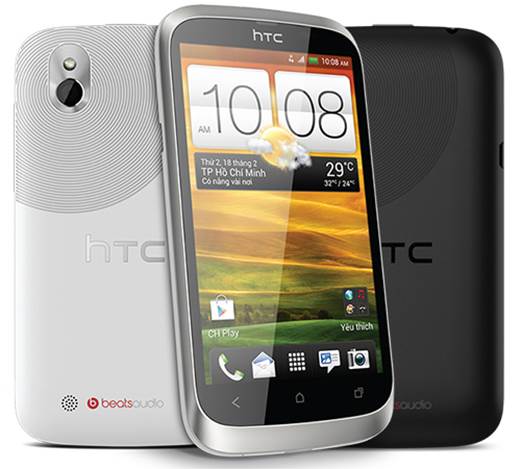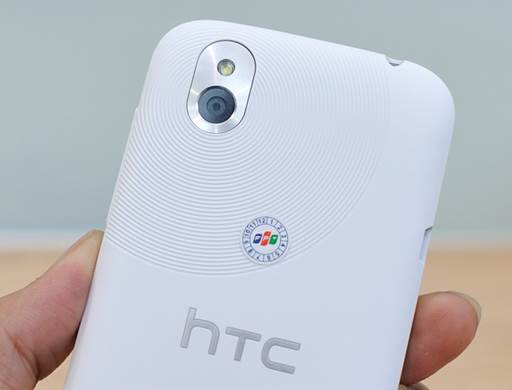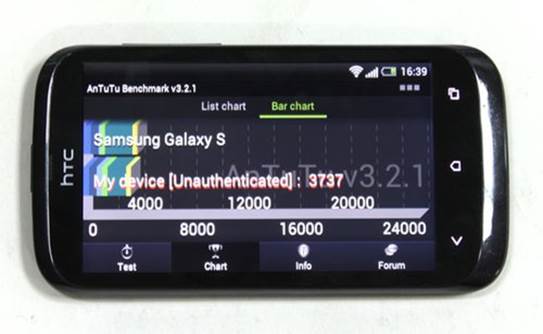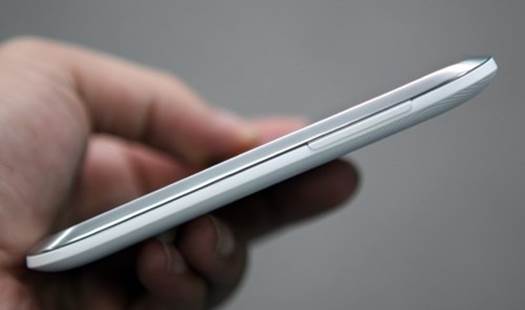The HTC Desire U is appropriate for those
who prefer stability and durability. The device combines beautiful display,
eye-catching interface and many smart features that have been integrated.
The HTC Desire U can be considered a Desire
V version that has been upgraded and improved with a few points in the design.
Therefore, there are not many differences and this is a product for the
mid-range segment with the price at around $200.
The version which we are testing is
designed to have just one SIM slot. The device’s specifications are not powerful,
using single-core 1 GHz Qualcomm S4 processor, 512 MB RAM, Adreno 200 graphics,
4GB of storage memory (actually used 2.5 GB) with memory card slot support,
running on Android 4.0...

The
4-inch Super LCD screen is so bright and clear.
Compared to the Desire V, this device uses
a 4-inch Super LCD screen of 800 x 480 pixels resolution; the pixel density is
233 ppi so detailed; color and contours quite clear when viewed directly. It
has 3G connectivity, standard Wi-Fi n, Bluetooth, GPS support... It has a 5
megapixel camera, which is equivalent to 2592 х 1944 pixels, with autofocus and
LED flash, and battery with 1650 mAh capacity.
Design
Similarly to the Desire V version, the
device has a metal chassis around the glass screen protector. The power button
is located on the top, which makes it more convenient to use with one hand. The
back of the device is made from scratch-resistant polycarbonate plastic and is stylized
with circular patterns around the camera lens. However, the camera is designed
to be more compact than on the previous products. Just on the upper edge are
the Beats Audio logo and the speakers that are designed rounded.

Similarly
to the Desire V version, the device has a metal chassis around the glass screen
protector.
On the inside, the design of the memory and
SIM card slot is not pinched by the battery so users can easily replace them
without fear of the device being turned off. The power button on the top is a
bit shallow, and the key is too small, making pressing and holding buttons to
display the restart function somewhat difficult.
Screen
The screen is different than that of the
Desire V. In the test of brightness adjusted to 100%, the color quality is
brilliant but nuanced with a bit yellow. However, when looking at a leaning
angle, colors are not changing much, the contrast of the device is quite good,
black display quality got about 90%, so when looked at under the sun, strokes
and details are still clearly visible. Although at the maximum brightness
adjustment, the screen does not burn much when used continuously.
Camera
The quality of the photos is quite good,
especially the autofocus speed is stable and fast in terms of full daylight
condition. When in low-light conditions, the device depends largely on the LED
flash, then image quality is bright and good, but when selected in night mode
or macro, the ability to handle, compared to in normal shooting mode, is not so
different.
Images are taken with clear contrast color;
the edges in the center is pretty clear. However, when taking photos of group
activities or scenes with so many details, the device cannot handle everything,
which leads to several blurry places. In case of shooting in the light or
low-light conditions, the device is slow and its white balance is just as only
acceptable.

HTC
Desire U’s camera
Other features
It uses Android 4.0 operating system with
the dynamic Scene 4.0 interface, which is highly customizable consisting of
five individual parts: Scene, Skin, Wallpaper, Lock Screen and Home Screen...
but compared with some high-end smartphones from the same manufacturer, its
interfaces do not have many to choose from, such as the Skin: there are only
two templates to choose from, the Beat sound is still activated when used with
headphones.
Some important advantages of third-party
apps that are embedded in this HTC device are Flashlight (torch), HTC car
(including a variety of applications such as navigation, online music or phone
calls with a horizontal keypad interface...). The “Show me” feature allows the
user to download detailed video tutorials of the steps for using the device,
such as changing the interface, taking a snapshot or editing photos...
Especially, the Wi-Fi hotspot function is
very useful when the user can quickly use the phone and the laptop connected to
each other and share the 3G data transmission, to surf or access social
networks faster. In the actual testing, this feature is stable within a 20 m2
area; the 3G data transfer conditions in strong coverage areas can allow
reading newspapers, watching news or checking email, but with entertainment
tasks such as watching movies or listening to online music, it is hard to
satisfy users. When used continuously, the phone becomes a bit warm but that
does not affect much. If the phone lags a bit, and you should wait about 5
seconds in order for it to be able to return to the normal operation.

Performance
Due to having low specifications and using
a single-processor, the performance is not so high; the tests it still passed ,
for example, it reached 3,737 points in AnTuTu, achieved 1,795 points in
Quadrant and 19.6 frames/s in Nenamark 2. This is a lower figure than that of
other products with the same price in the market.

Due
to low specifications, its performance is limited, in AnTuTu it only got 3,737
points.
Thus, in terms of actual performance, the
performance is quite heavy, especially when opening multiple web pages with
embedded flash ads. In addition, the RAM capacity is 512 MB but the real that
can be used is only 405 MB as it has to be shared with the graphics, which
influences so much in running multiple tasks or opening many programs. However,
with applications or websites programmed on mobile platforms, opening them is
faster, handling them is better and there is no problem mentioned above. Users
should keep in mind that when using the device, they should not install too
many applications that can affect the performance of the device, which causes
it to run heavily and lag also.
Battery life
Battery life can be considered the
advantage of the machine, although using the 4-inch Super LCD display, the
battery lasts so long. In an experiment with brightness set at 50% (enough for
all needs), FM radio on with headphones, combining social networking access
with Wi-Fi connectivity, sometimes switching to using 3G and calling/sending
messages about 20 times, the device can last up to about 12 hours until battery
depletion. In case you reduce the brightness at 30%, turning off all data
connections that are not necessary, you can use it for a long time, up to two
days.
Conclusion
Overall, the HTC Desire U is another
version of the Desire V with an upgraded screen, which is suitable for users
who love stability and durability besides a beautiful screen, eye-catching
interface and many built-in smart features.

HTC
Desire U is another version of the Desire V with an upgraded screen.
Advantages
·
Nice screen
·
Elegant design
·
Good image quality
·
Effective battery

Elegant
design
Disadvantages
·
Low specifications
·
The price is inappropriate
Overview
·
Another version of the Desire V with an upgraded
screen, which is suitable for users who love stability, high durability, long
battery life and a beautiful screen from HTC.
|
Specifications
·
SIM: dual SIM
·
Dimensions: 118.5x62.3x9.3 mm (4.67x2.45x0.37
inches)
·
Weight: 114 g (4.02 oz)
·
Display type: Super LCD capacitive
touchscreen, 16M colors
·
Display size: 480x800 pixels, 4.0 inches (~233
ppi pixel density)
·
Multi-touch: yes
·
Memory card slot: microSD, up to 32GB
·
Internal memory: 4 GB storage, 512 MB RAM
·
NFC: optional
·
Primary camera: 5 MP, 2592х1944 pixels,
autofocus, LED flash
·
Camera features: geo-tagging
·
Video: yes, WVGA
·
Secondary camera: no
·
OS: Android OS, v4.0 (Ice Cream Sandwich)
·
CPU: 1 GHz
·
Sensors: Accelerometer, Proximity
·
Battery: Li-Ion 1650 mAh battery
|